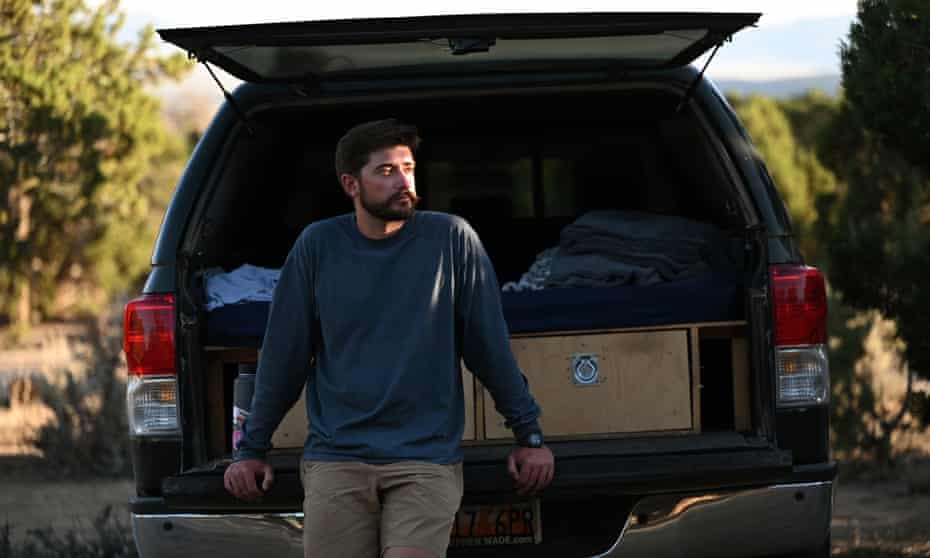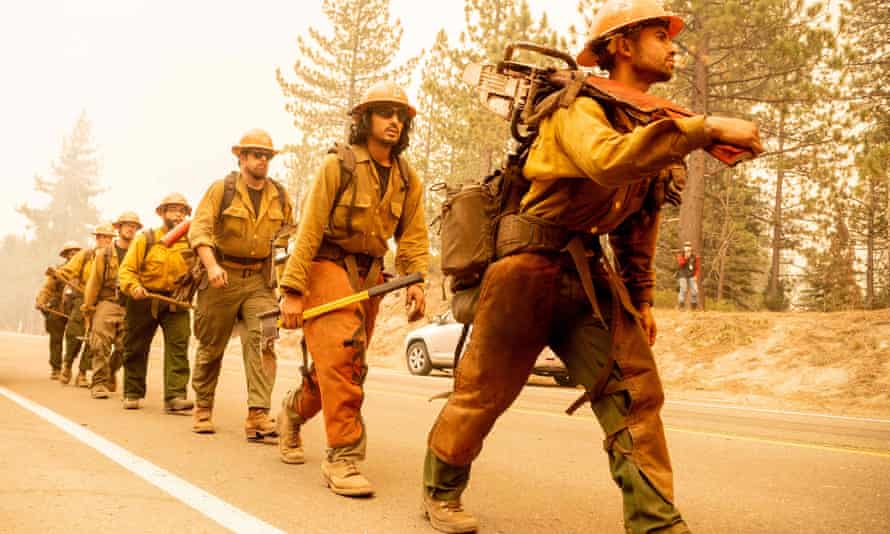‘Nobody cares I have nowhere to live’: wildland firefighters struggle with homelessness
As wildfires consume the American west, economic uncertainty plagues those tasked with containing them

Last modified on Thu 21 Oct 2021 06.01 EDT
During his first season as a wildland firefighter with the Idaho Department of Land, Luke Meyer camped out in a decrepit building infested with rodents. It was 2017 and he was a 20-year-old rookie earning $11 an hour. In the rural community where he worked, outside Bonners Ferry, Idaho, housing was scarce and rent was a luxury he couldn’t afford.
Meyers kept a mattress inside a tent on the floor of his temporary home, provided for free by his employer, to prevent mice from crawling across his chest as he slept.
Working his way up the ranks did little to upgrade Meyer’s living conditions. Four fire seasons later – with thousands of firefighting hours logged, a new job with the US Forest Service and fresh certifications to supervise small crews – Meyer was living out of the back of his truck.
“I love this job and the people I work with,” said Meyer. “But is it worth living like this, with so much uncertainty?” The answer, he decided, was no. His last day as a wildland firefighter was 27 August.
At a time when wildfires are forcing communities to evacuate or live under layers of ash and smoke, workers say they are being squeezed out of wildland firefighting by low pay and few options to find affordable housing.
“I’m on food stamps and I live in a shack in someone’s back yard. It’s the only housing I can afford,” said a member of an elite helitack unit with the Forest Service in Arizona who makes $15 an hour ferrying crews into fire zones via helicopter. Previously, he’d lived in a van without air conditioning and once suffered from heatstroke after temperatures rose above 109F.
As climate change drives droughts and extreme heat across the western United States, wildfire season continues to grow in length and severity. Blazes largely concentrated in the American west have burned more than 5.6m acres since January, and nearly 18,000 fire personnel were deployed across the country.

The demand is overwhelming crews that are already stretched thin. With the tempo of work unlikely to let up anytime soon, many wonder if there’s any future in the world of wildland firefighting.
“Every year I question if I’ll come back next season,” said a 35-year-old firefighter with the Forest Service. “If you’re looking to settle down with a home and a family, this career keeps that at arm’s length.”
Chasing overtime
Speaking on condition of anonymity, several wildland firefighters of varying age and rank told the Guardian about their experiences with homelessness and persistent economic uncertainty.
The workforce is dependent on large numbers of temporary and seasonal workers who spend four to six months on the job, often far from family, and are then laid off at the end of fire season. Wages typically hover between $15 and $20 an hour, even for highly experienced wildland firefighters, forcing many to depend heavily on overtime pay to pad their incomes and last them through the off-season.
“I survive by chasing as much overtime as I can,” the 35-year-old Forest Service firefighter said. “Sometimes I’m working 80 to 100 hours a week.”
Several agencies, such as the Bureau of Land Management, say they plan to convert more seasonal job openings into permanent positions, acknowledging the growing demands wrought by climate change and the necessity of providing its workforce with a stable and financially viable career path.
But workers continue to struggle to find affordable housing. None of the federal agencies that oversee wildland firefighting guarantee lodging for all workers. Some locations offer spaces in bunkhouses free of charge or at reduced rates, but employees say these benefits are inconsistent.

“I’ve gone from living comfortably in a bunkhouse for a little over $100 a month one season to being miserable living out of my car the next,” said a 37-year-old member of a helitack unit with a decade of experience with the Forest Service who makes $20 an hour.
Another 29-year-old Forest Service worker noted his hourly wages are not enough to afford rent in California. He has spent the season living in a tent next to his car. “Sometimes lodging is provided, but usually, it’s not,” he said. “It can vary dramatically from season to season.”
Other firefighters argue they’re incentivized to live out of their vehicles during fire season.
“I bought a truck because I figured it would open up more opportunities,” said a 23-year-old firefighter with the Forest Service in Montana. “And I was right. People were significantly happier to hire me because they knew I’d be living in a car and wouldn’t need help with lodging.”
Such uncertainty can take a toll on the mental health of firefighters, as well as on loved ones and families. Michelle Hart, whose husband, Tim, died from injuries sustained while parachuting into a fire zone last summer, says that her husband struggled with housing issues for years.
“For three seasons he lived in his truck. He had to pay to park in a field with other smokejumpers,” she said. “Some literally slept in the front seat of their cars. I saw the toll it took on him, and I know a lot of firefighters are dealing with the same issue.”
Those issues, along with other strains that stem from the dangerous nature of firefighting, have a cost that is not abstract for many. “By the end of my second season two of my peers had died by suicide or substance abuse,” said the 35-year-old.
New hope for a ‘fatigued workforce’
With the scope of wildfires becoming impossible to ignore, politicians have started to address how workers are affected. On 19 October, Representative Joe Neguse introduced the Tim Hart Wildland Firefighter Classification and Pay Parity Act with Representatives Katie Porter and Liz Cheney, which would overhaul federal firefighter pay, benefits, and worker classifications. Tim’s Act is named after Michelle’s husband, Tim Hart.
Neguse told the Guardian that the low pay experienced by wildland firefighters was “simply outrageous”. His bill, which is a piece of standalone legislation, would raise hourly pay to $20 an hour, provide housing stipends for firefighters on duty more than 50 miles from their primary residence, extend retirement benefits to temporary and seasonal workers, and expand mental health benefits, among other provisions.
On a recent visit to the western United States, Joe Biden used the spectacle of the fires to promote his $1tn infrastructure bill, which also includes investments in climate resiliency and $600m for wildland firefighters. If passed, it would result in an estimated yearly salary increase of $20,000 for federal wildland firefighters. But with the future of the infrastructure bill uncertain, Tim’s Act may become the focus of legislative efforts to improve the position of wildland firefighters.
But others, such as the advocacy group Grassroots Wildland Firefighters, would like to see the government think bigger in providing housing and healthcare benefits. “We’re happy to see this issue getting more attention,” said Jonathon Golden, a policy adviser with Grassroots. “But we’re seeing a fatigued workforce. There’s been a lack of investment and that needs to change long-term.”
After over a decade with the Forest Service, the 37-year-old helitack unit worker feels pangs of guilt that his family has had to make sacrifices due to the instability of his profession.
“My wife has basically had to shape her life around the whims of the Forest Service,” he said. “When I was living in my car sometimes I just called her at night crying. You start to think, well, nobody seems to care that I have nowhere to live. Maybe this is just what I deserve.”
.png)